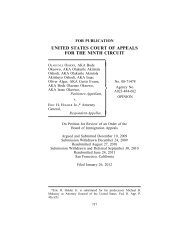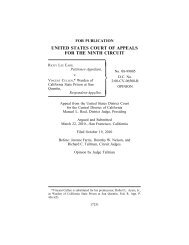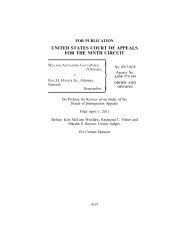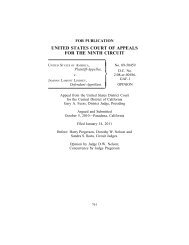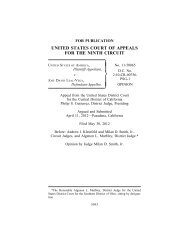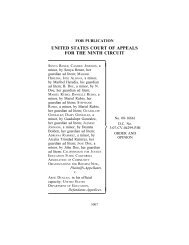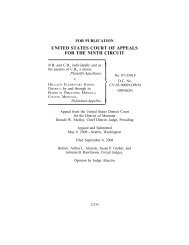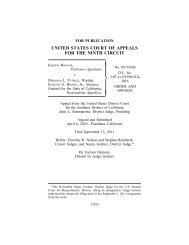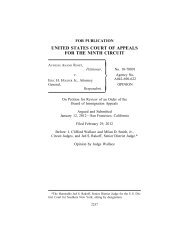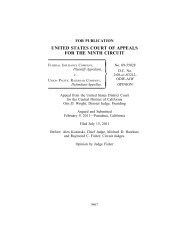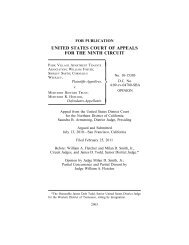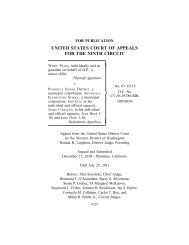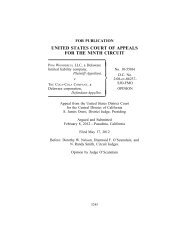USA v. Xavier Alvarez - Ninth Circuit Court of Appeals
USA v. Xavier Alvarez - Ninth Circuit Court of Appeals
USA v. Xavier Alvarez - Ninth Circuit Court of Appeals
Create successful ePaper yourself
Turn your PDF publications into a flip-book with our unique Google optimized e-Paper software.
UNITED STATES v. ALVAREZ<br />
11863<br />
ified “the knowingly false statement . . . do[es] not enjoy constitutional<br />
protection.” 379 U.S. 64, 75 (1964) (emphasis<br />
added); see also Sullivan, 376 U.S. at 283.<br />
[6] Moreover, Garrison’s clarification is not the only relevant<br />
refinement. In defamation jurisprudence, the question<br />
has never been simply whether the speech “forfeits [First<br />
Amendment] protection by the falsity <strong>of</strong> some <strong>of</strong> its factual<br />
statements.” Sullivan, 376 U.S. at 271. The question is always<br />
whether the speech forfeits its First Amendment protection as<br />
a result <strong>of</strong> its falsity “and by its alleged defamation <strong>of</strong> [the<br />
plaintiff].” Id. (emphasis added). In other words, in a defamation<br />
case, a threshold question is whether the false speech at<br />
issue is defamatory, meaning that the defamer’s false statement<br />
is the proximate cause <strong>of</strong> an irreparable 8 harm to another’s<br />
reputation. See Gertz, 418 U.S. at 347 (holding that “so<br />
long as they do not impose liability without fault, the States<br />
may . . . [impose] liability for a publisher or broadcaster <strong>of</strong><br />
defamatory falsehood injurious to a private individual”).<br />
8 On the importance <strong>of</strong> irreparability, see infra pp. 11869, 11879-80. The<br />
dissent argues at length that we have conjured up this harm element out<br />
<strong>of</strong> whole cloth, see Dissent at p. 11910, but it comes directly from several<br />
<strong>of</strong> the cases about “unprotected” speech. See, e.g., Chaplinsky, 315 U.S.<br />
at 572 (identifying fighting words as “those which by their very utterance<br />
inflict injury or tend to incite an immediate breach <strong>of</strong> the peace”) (emphasis<br />
added); Gertz, 418 U.S. at 347 (describing defamation as “injurious”).<br />
We do not mean to suggest, however, that harm is necessarily a required<br />
element for all unprotected speech regulations (although we find it interesting<br />
that it is present in many <strong>of</strong> them); rather, we note here only that<br />
it is a required element <strong>of</strong> defamation. Defamation, like every “unprotected”<br />
category, involves thoughtful and unique definitional analysis, see<br />
infra n.9. Even obscenity doctrine, which the dissent argues includes no<br />
harm element, still requires the statute to define “obscenity” in conformity<br />
with the constitutional rule. See, e.g., Paris Adult Theater I v. Slaton, 413<br />
U.S. 49 (1973) (reaffirming that obscenity is unprotected, but holding the<br />
an anti-obscenity statute must be carefully drafted or construed to meet<br />
First Amendment standards). Thus, if defamation law supplies the rule to<br />
be applied in this case, we cannot ignore that the definition <strong>of</strong> defamation<br />
includes injury to reputation. See, e.g., Gertz, 418 U.S. at 347; Sullivan,<br />
376 U.S. at 271; Dun & Bradstreet, 472 U.S. at 762.



